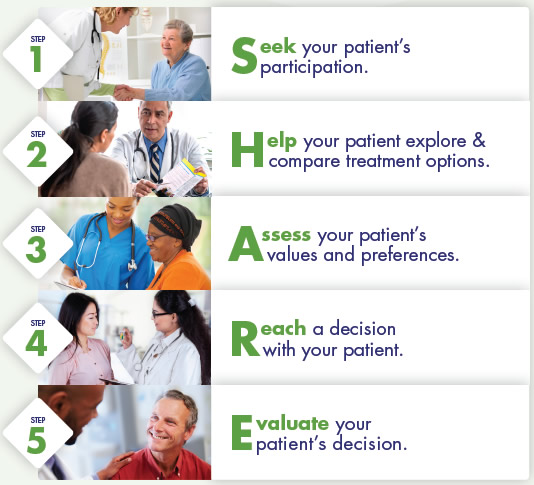This post about shared decision-making is the first in a series that discusses in depth each of the domains of patient-centered/person-centered care (PCC) which were first mentioned in a previous blog examining what PCC really means. You can find that blog here. In this series, I hope to elaborate on each of the domains, discuss their definitions, barriers to implementation, controversies and, if at all possible, I hope to give some insight into how we can go about implementing them in our clinical practice. The information and thoughts in these writings are what I’ve learned as I’ve scoured the literature on PCC for my PhD dissertation. I hope you’ll join me for the ride and find these discussions insightful!
A popular dimension of patient-centered care
So when we typically think of PCC, the first thing that usually comes to mind for many of us is shared decision-making (SDM). This is even supported by the research, as Langberg et al1 found that the domain of “sharing power and responsibility” was the most studied in their systematic review. The theme appeared in 76 out of the 80 articles reviewed, modestly followed by the therapeutic alliance with appearances in 63 articles. The popularity of shared decision-making has certainly been rising in recent times, with 10 models of the construct being published just between 2018 and 2019!2 This growing recognition is likely due to the changing face of healthcare, as value-based models become more popular and focused on PCC, and patient agency takes center stage as healthcare consumerism rises.

What is shared decision-making?
But what really is SDM? What does it entail and how can we as healthcare professionals practice it? There is no one specific definition for shared decision-making, but it is usually understood as patient empowerment to participate in their care, or as an egalitarian relationship between patient and provider. The term respects patient autonomy and has been seen as the ethical solution to the controversial paternalistic style of care where the patient is a passive recipient, subservient to the power of the physician. Hutting et al3 recently defined it as involving “mutuality, combining the skills of healthcare professionals, with the patients’ experience.” It relies heavily on the patients’ values, goals, needs and knowledge, and can take different forms depending on these contexts. Shared decision-making is therefore a complex process, but it does involve the following core components3:
- Identifying and clarifying the issue at hand
- Identifying potential solutions
- Discussing options and uncertainties
- Providing information about the potential benefits, harms and uncertainties of each option
- Checking that patients and professionals have a joint understanding
- Gaining feedback and reactions
- Agreeing on a course of action
- Implementing the chosen treatment
- Arranging follow-up
- Evaluating outcomes and assessing the next steps
Be a rockstar and share the infographic at the end of this post to increase awareness of what shared decision-making is!
That roadmap seems pretty straightforward. It makes SDM seem like a checklist of behaviours. Shared decision-making probably is easy to implement when there are few choices of interventions, and also when one of these interventions is unambiguously the correct choice. But as we all know, and have experienced, clinical practice is seldom so easy, and the construct cannot be reduced to checking behaviours off a list. It requires a much more nuanced and skilled approach in many clinical encounters. Both our patients and therefore ourselves as clinicians, are faced with difficult decisions about interventions that may have some undesired outcome, yet be useful in some way.
The situations can be as difficult as having a drug that will cure one ailment, but which has horrible side effects that can put our elderly patient with osteoporosis at risk for falls or lead to some other condition. Or, it can be a typical clinical situation, such as the one I had with a patient who was a single mother during the pandemic. She came to see me for knee pain related to a meniscus injury. In the beginning, she had agreed to come to clinic twice a week. However, I realised that she dropped that to once a week after her first week. When I asked her about it, I learned that she was having difficulty making time to come to the clinic twice a week because she was home-schooling her children while working full time. I also discovered that she was only exercising once a week, which would not help her knee much. We sat that day, had a discussion, both of us as experts in our own right (my expertise in how exercise works and her expertise in her life and what is reasonable for her to accomplish). We decided on one clinic session a week and one other day of independent exercise at home. She was discharged pain free 4 weeks later after being able to adhere to this plan.

Shared decision-making looks different in different contexts
This kind of SDM looks very different to other situations and clinical settings that may involve more difficult decisions, or life-threatening cases, or family members who may part-take in the decision-making process. Shared decision-making is such a complicated process that 40 different models were identified in a recent systematic review review!2 No one unified model exists and this reflects the lack of a standard definition of the construct of SDM. It is a similar issue to that faced by PCC which also lacks a standard definition, as I discussed in my blog here.
This makes measurement and implementation of SDM, as well as professional training and development of policy around the construct particularly challenging. It is no wonder that researchers have attempted to develop so many models to allow both measurement and implementation!
I highly recommend a read of Bomhof-Roordink et al.2 It’s an open access article that beautifully describes the evolution of the components of SDM, and it has some great graphics to illustrate these trends as well! The authors performed a systematic review of all the models/definitions (they used the term “models” to include “definitions”) of SDM between 1997 and 2019. They analysed 40 articles and determined 24 elements of SDM.
The most frequently appearing elements were:
- Describe treatment options (88%)
- Make the decision (75%)
- Patient preferences (68%)
- Tailor information (65%)
- Deliberate (58%)
- Create choice awareness (55%)
- Learn about the patient (55%)
The focus on patient values and preferences here is similar to the SHARE Approach model for SDM advocated by the Agency for Healthcare Research and Quality (AHRQ). The 5-step approach to SDM can be seen in the graphic below which is found, together with more resources on SDM, at the AHRQ website https://www.ahrq.gov/health-literacy/professional-training/shared-decision/tools/factsheet.html
A preference for paternalism?
The above website and graphic have really great information for getting the patient involved in making decisions about their care. However, if you’re a clinician, I’m pretty certain you’ve come across those patients who prefer not to part-take in the decision-making process and instead would like you as the provider to tell them what to do. Here in Trinidad, I experience that a lot, and a common statement is “I’ll do whatever you think is best, Doc.” I don’t think that this reflects a lack of interest in participating in their care. Rather, it’s partly because of a deep-seated cultural belief that the “doctor knows best.”
This preference for a more paternalistic style of care, is particularly evident in older patients and those from lower socio-economic brackets. This is actually supported by the literature.4–7 In fact, Naylor et al8 stated that “A dogged pursuit of person-centredness in the face of patient resistance to the “activated” roles required by this model, i.e., where paternalism is preferred to shared decision-making, could lead to a “person-centred paradox.” So as healthcare providers, although we may want the patient to be part of the decision-making process, sometimes it is actually more person-centered to assume a more paternalistic style with certain patients.
Shared decision-making as a continuum
I prefer to see SDM as a continuum, with paternalism on one end of the spectrum and a more consumerist approach on the other end. In my clinical practice I see both the patient who wants to be told what to do, and the other patient who is shopping around and just wants information from her clinician which will determine what she decides about her healthcare. I’ve also seen everything in between. There are other models that reference this continuum, and give names to different styles of SDM.9–11 For example, Wirtz9 identifies 4 types: paternalistic, deliberative, shared and informed (consumerist).
However, I think that SDM during a single patient’s clinical course can take many forms as the patient progresses through the episode of care. I’ve experienced timid patients, who initially preferred a more paternalistic style, begin to assume more power in their care process as they became more comfortable and confident. I have also seen other patients who began as entitled, information-seeking, independent decision-makers mellow out and ask for advice and opinions as they developed more trust in me as a provider. To me, SDM is a nuanced, complicated process, where patient preferences, experiences, values and beliefs, and even levels of trust and comfort are key determinants in how they participate in their care process.
A Formative Process
I think that Dowie12 said it best when he referred to shared decision-making as a “formative process as opposed to a single construct.” He advocates for the use of “sdm” instead of “SDM” to indicate this, and argues that the current thinking of SDM narrows the topic to a single construct that is focused on patient autonomy. He promotes the view of sdm as a pluralist construct, rather than a universal standard, that is more of a “socially-constructed field of inquiry and activity.” I couldn’t agree more with him!
Whatever the challenge of the definition, a foundational element is communication between patient and provider. Once you’re able to understand your patient, as a good clinician you can tailor your interaction and care-giving process to suit the preferred style of decision-making that your patient prefers or needs at that particular time.
Wrapping Up
I hope that I’ve shown that sdm is a fluid construct, not easily defined. It is a highly plural concept with diverse and context-dependent presentations. I reiterate that it is not a list of steps or behaviours that you can check off a list as you preform them. Rather, the enactment of sdm in the clinical encounter requires skill, nuance, good communication and maybe even professional training.
So that wraps up the first part of the series of in-depth discussion on the domains of person-centered care. Please stay tuned for the remainder of the series. I’m really curious about your thoughts and experiences, so please comment below and let’s have a discussion!
As a reminder, I’d appreciate if you would share the infographic below to help me spread the word about the elements of person-centered care. Also, I’d love your company on this journey as I explore everything about person-centered care, so come along for the ride!
References
- Langberg EM, Dyhr L, Davidsen AS. Development of the concept of patient-centredness – A systematic review. Patient Educ Couns. 2019;102(7):1228-1236. doi:10.1016/j.pec.2019.02.023
- Bomhof-Roordink H, Gärtner FR, Stiggelbout AM, Pieterse AH. Key components of shared decision making models: a systematic review. doi:10.1136/bmjopen-2019-031763
- Hutting N, Caneiro JP, Ong’wen OM, Miciak M, Roberts L. Patient-centered care in musculoskeletal practice: key elements to support clinicians to focus on the person. Musculoskelet Sci Pract. Published online 2021:102434. doi:10.1016/j.msksp.2021.102434
- Sam S, Sharma R, Corp N, Igwesi-Chidobe C, Babatunde OO. Shared decision making in musculoskeletal pain consultations in low- and middle-income countries: a systematic review. Int Health. 2020;12(5):455-471. doi:10.1093/inthealth/ihz077
- Xanthos C. Delivering a patient-focused health service: The views of physicians in Barbados. Health Sociol Rev. 2007;16(3-4):263-278. doi:10.5172/hesr.2007.16.3-4.263
- Schouten BC, Meeuwesen L. Cultural differences in medical communication: A review of the literature. Patient Educ Couns. 2006;64:21-34. doi:10.1016/j.pec.2005.11.014
- Dukhu S, Purcell C, Bulley C, Queen Margaret University, Edinburgh. Person-centred care in the physiotherapeutic management of long-term conditions: a critical review of components, barriers and facilitators. Int Pract Dev J. 2018;8(2):1-27. doi:10.19043/ipdj.82.002
- Naylor J, Killingback C, Green A. What are the views of musculoskeletal physiotherapists and patients on person-centred practice? A systematic review of qualitative studies. Disabil Rehabil. Published online 2022:1-12. doi:10.1080/09638288.2022.2055165
- Wirtz V, Cribb A, Barber N. Patient–doctor decision-making about treatment within the consultation—A critical analysis of models. Soc Sci Med Med. 2006;62(1):116-124. doi:10.1016/j.socscimed.2005.05.017
- Oprea L. An analytic review of the doctor-patient relationship part I. Rev Romana Bioet. 2009;7(2). Accessed April 4, 2022. https://www.proquest.com/docview/1417962100/abstract/B2203249E4784294PQ/1
- Oprea L. AN ANALYTIC REVIEW OF THE DOCTOR-PATIENT RELATIONSHIP (part II). Romanian J Bioeth. 2009;(3):12.
- Dowie J. shared decision making is a Preference-sensitive Formative Construct: the Implications. Eur J Pers Centered Healthc. 2019;7(3):506-517. doi:10.5750/ejpch.v7i3.1759







2 thoughts on “What does good shared decision-making look like?”
Pingback: The Therapeutic Alliance: An Exploration of an Under-rated Healing Agent - carlarauseo.com
Pingback: The Indispensable Role of the Clinician in Person-centered care - carlarauseo.com